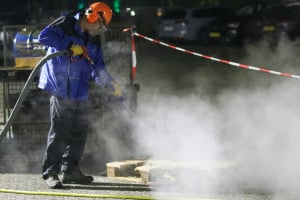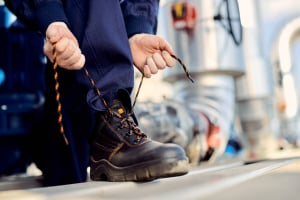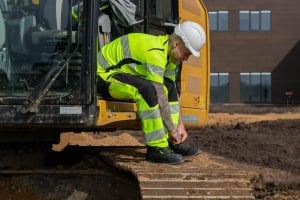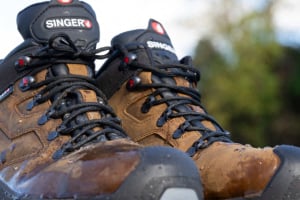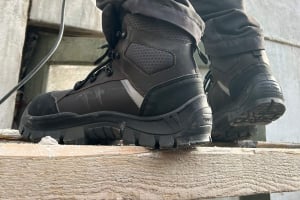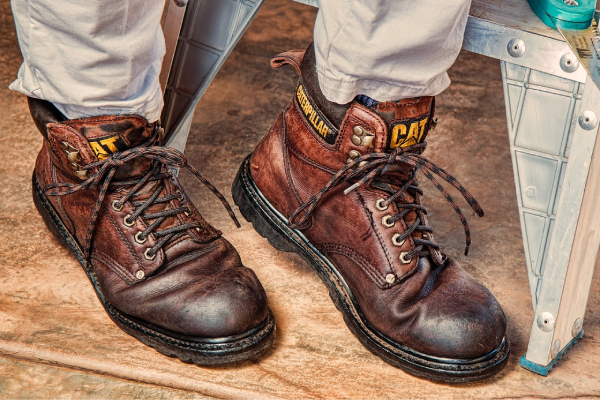
Understanding safety shoe standards
Choosing the right safety shoes is crucial to ensuring safety in the workplace. The standards governing these shoes are not simple recommendations: they are the result of technological and regulatory developments responding to specific risks. This article aims to shed light on the importance of these standards and to detail their different classifications which, for an uninformed person, can be difficult to understand. For security professionals or any employee concerned about their protection, understanding these guidelines is essential for an informed choice.
Summary
The foundations of footwear safety standards
The appearance and growth of safety standards for footwear is closely linked to changes in working conditions and technological progress. Initially basic, these standards have grown to cover a wider range of risks, from mechanical threats to chemical and thermal hazards. This evolution has led to the introduction of characteristics such as puncture resistance, protection against shocks and even improved grip on the ground.
These standards mainly aim to:
- Protect against physical injury: This includes protection against falling objects, punctures and cuts.
- Prevent accidents: Features like slip resistance help prevent falls and other incidents.
- Ensure comfort and support: Adapted shoes prevent pain and support health in order to avoid MSD (Musculo-Skeletal Disorders) for workers.
Standards are dynamic and evolve with new discoveries and the changing needs of business environments. They are the result of a collaboration between health and safety experts, engineers and industry professionals, guaranteeing their relevance and effectiveness.
Detailed presentation of security standards
Understanding the standards forsafety footwear is essential for choose the right equipmentfor each work environment. These standards, well established and internationally recognized, define precise criteria to ensure the safety and comfort of users.
Explanation of ISO and EN Standards
- ISO Standards: They provide an international framework for the quality and safety of footwear, ensuring uniformity across different markets.
- EN (European) Standards: Specific to Europe, these standards include detailed requirements for the manufacturing and performance of safety footwear.
Decryption of Standard Codes and Symbols
Codes like SB, S1, S1P, S2 and S3 indicate the level of protection offered by the shoes:
- SB: Basic safety, with toe protection against impacts up to 200 joules.
- S1: Includes the features of SB, plus closed heel zone, anti-static, and energy absorption in the heel.
- S1P: Like S1, but with puncture resistance.
- S2: Like S1, but suitable for humid environments with a water-resistant upper.
- S3: Like S2, with the addition of puncture resistance and a notched outsole.
Meaning and Implications of Each Classification
Each classification meets specific needs:
- The SB and S1 standards are suitable for relatively safe working environments.
- S1P and S3 are recommended for areas where the risk of perforation is high.
- S2 and S3 are suitable for humid environments, with S3 providing additional protection.
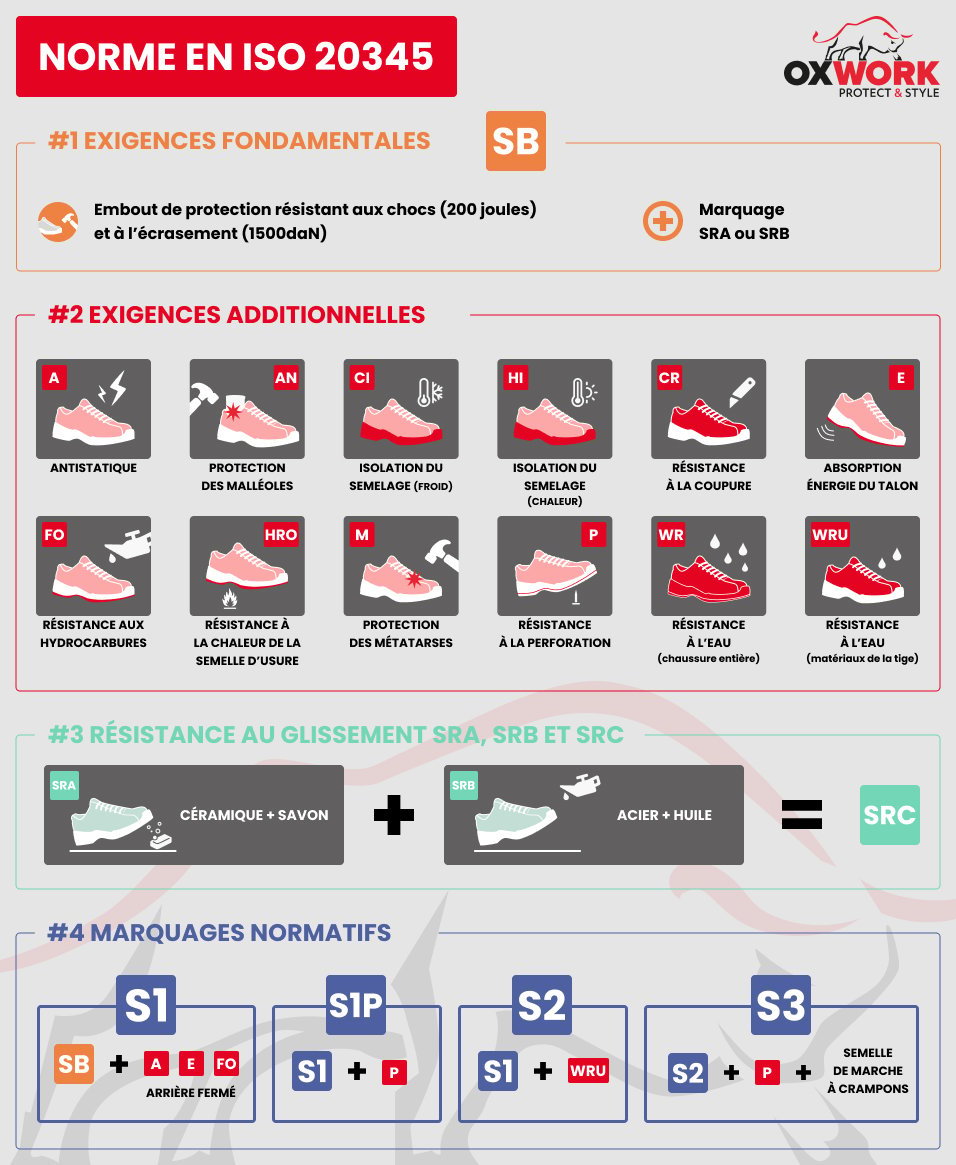
Application of standards according to sectors of activity
The application of safety footwear standards varies between sectors due to differences in risks and working conditions.
Examples of Use in Various Sectors
- Construction: S3 standards for complete protection (puncture resistance, shock absorption, non-slip soles).
- Industry: S1P or S3 standards, for resistance to puncture and protection against electric shock.
- Food sector: S1 or S2 standards for slip resistance.
Factors to Consider Depending on the Work Environment
- Nature of Risks: Evaluate the specific risks (shocks, perforation, slips, chemicals, etc.).
- Comfort and Ergonomics: Important for workers standing for a long time.
- Climatic Conditions: Adaptation necessary, for example, S3 standards for humidity or cold.
Understanding Tests and Certifications
The certification of safety shoes involves rigorous testing carried out by accredited organizations to assess several critical aspects:
- Material Strength: Tests the durability and strength of the materials used, ensuring they can withstand everyday wear and tear as well as extreme conditions.
- Impact Protection: Assesses the shoes' ability to protect the feet against forces such as falling heavy objects. This is often measured in terms of joules (a unit of energy).
- Electrical Resistance: Essential in environments where electrical hazards are present. These tests ensure that the shoes can effectively insulate the user's feet from electrical charges.
- Sole Durability: Checks the soles' resistance to puncture, their grip and their ability to withstand different terrains and surfaces.
Understanding Labels and Certifications (CE, ANSI, etc.)
- CE label (Europe): Footwear bearing the CE label has been tested and found to comply with European safety, health and environmental protection standards. Tests are carried out by notified bodies based in the European Union.
- ANSI Certification (United States): ANSI certification indicates compliance with the standards of the American National Standards Institute. Testing for this certification is performed by accredited laboratories in the United States, which follow ANSI standards for personal protective equipment.
These labels and certifications are not only marks of conformity; they represent a commitment to quality and safety, ensuring that products have undergone thorough evaluation and meet strict criteria. Safety shoe manufacturers must submit their products to these tests regularly to maintain their certification, ensuring that the shoes you use are reliable and safe.
Selection and Purchasing Based on Standards
Selecting the right safety footwear requires a thorough understanding of the risks specific to your work environment. Here's how to do it:
- Identify Work Environment Risks: Assess hazards - falling objects, electrical hazards, slippery surfaces, etc. This assessment will help you determine the necessary classification (such as S1, S1P, S2, S3).
- Select Shoes Offering the Necessary Protection: Depending on the risks identified, choose shoes that offer adequate protection. For example, for environments with a risk of perforation, opt for shoes classified S1P or S3.
At Oxwork we offer a wide reference range of safety shoes and we cover all existing standards. We offer a categorization by profession of professional equipment meeting industry standards, thus saving you from having to define yourself the standards necessary for your activity. Do not hesitate to contact us if any doubt persists so that together we can select the products that will suit you best.
Tips for Verifying Compliance and Authenticity of Certifications
- Check Labels (CE, ANSI): Make sure that the shoes carry recognized certification labels, guaranteeing their compliance with safety standards.
- Buy from Reputable Suppliers: To avoid counterfeits, buy your safety shoes from reliable and recognized suppliers in the field of professional equipment.
- Consult the Manufacturer's Website or Technical Data Sheets: For detailed information on footwear compliance and specifications, consult the manufacturer's online resources.
Conclusion
Choosing safety footwear that meets the appropriate standards is vital for workplace safety. This choice is not limited to complying with regulations, but it is essential to protect against the specific risks of each work environment. An informed choice means understanding the standards, identifying the dangers specific to your sector and opting for certified equipment.
By investing in appropriate safety footwear, we not only promote accident prevention but also a safer working environment for everyone. Therefore, the choice of safety shoes should not be seen as a simple regulatory formality, but as a key step to ensure our well-being and that of our colleagues.

